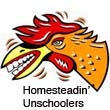First thing we did this morning (after chores and breakfast that is) was to hook up the trailer and head down to the feed store to pick up the 25 bales of hay that I pre-paid for on Tuesday. I would have liked to get more but at $8.75 a bale 25 was all that we could mange right now. That will bring our hay numbers up to 52 bales for the winter. To be on the safe side I would love to have twice that number put up. All this means is that I need to be conservative with the hay and not use any until we really need to. As long there is green grass in the pastures the livestock is just going to have to make do. Being a small farmer on a tight budget can be a struggle at times.
After getting the hay we did a bit of shopping in town since we were there. Got some food to stock the pantry and some new shoes, two pair of jeans and couple of shirts for Evan. He is growing so fast and with cooler weather coming on I can't get away with just putting him in shorts and sandals all the time.
Then this afternoon it was time for me to butcher the three roosters I had separated out from the flock last night. This was the first time I had butchered chickens all by myself (I had learned to do it in college). First I had to decide between the chopping block or using a "killing cone". I opted for the killing cone as the part I hate the most about the butchering process is having them flap around after they are dead (or dieing). The cone holds their wings against their body and prevents any of the flapping around. My "cone" was just a plastic gallon jug with the bottom cut off and the spout cut off to allow the head and neck to pass through. The jug was installed bottom up on the backside of the tool shed with a 5-gallon bucket on the ground to catch the blood.
One at a time the chickens were placed upside down into the cone. Chickens become very calm when held upside down which makes is very easy to put the chicken into the cone. So, with my first chicken in the cone I firmly held his head, took a deep breath, and using a sharp knife slit the jugular vein on one side of his neck. I continued to hold his head to keep him from shaking it, and blood, all over. I repeated that with the other two birds. Once that was done (which is by far the hardest part) I scalded the birds in a big pot of water I had sitting on the side burner of our outdoor grill. Time of scalding varies with the temp of the water and the age of the bird. My water was at 125 degrees and I swished them around (one at a time) for about 45 seconds to a minute. Once scalded the feathers come off by hand pretty easy. I then took the three birds into the kitchen to finish the remainder of the cleaning process. I would say it took 7-10 minutes per bird to remove the heads and feet and eviscerate them. This time should get closer to 5 minutes as I get more practice. Once they were all cleaned they went into a cold water brine (just water and salt) and placed into the fridge to age for 2-3 days. Once they age they can be cooked or frozen for later.
All in all the butchering process was not as bad as one might think it would be. Now I only have 15 more birds to go!
Saturday, September 22, 2007
Chicken Butchering
Labels: Chickens, Farm, kids, Pasture, Self-Sufficiency




1 comment:
ohh, i would probably faint seeing butchering. you are one brave woman.
i saw your comment in my blog. i am from across the world. Estonia.
Post a Comment